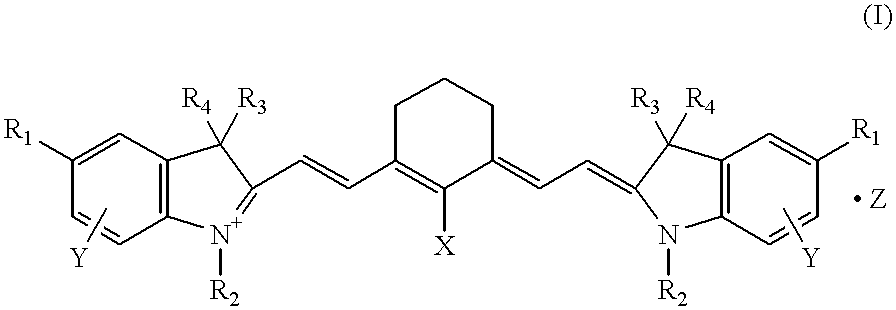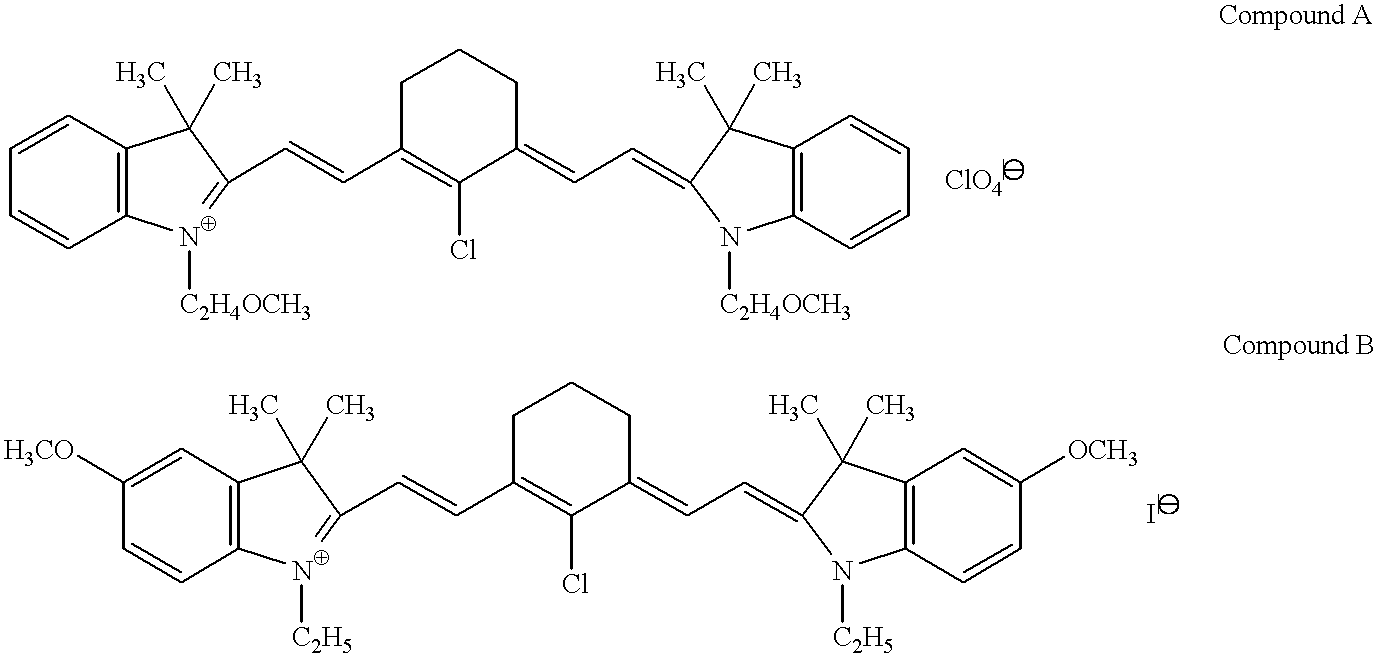Polymethine compounds, method of producing same, and use thereof
a technology of polymethine compounds and compounds, which is applied in the field of polymethine compounds, can solve the problems of objectionable background coloration, large-scale and expensive equipment for the manufacture of plate materials, and difficult to obtain heat energy required for image formation, etc., and achieves high light-to-heat conversion efficiency, good sensitivity to semiconductor lasers, and easy processing
- Summary
- Abstract
- Description
- Claims
- Application Information
AI Technical Summary
Benefits of technology
Problems solved by technology
Method used
Image
Examples
example 1
Polymethine compound [synthesis of compound (11)]
A compound of general formula (II) (R.sub.1 =methoxy, R.sub.2 =methoxyethyl, R.sub.3 =R.sub.4 =methyl, Y=7-methoxy, Z=ClO.sub.4.sup.-, n=1) (3.79 g), 0.86 g of a compound of general formula (III) (X=Cl) and 3.36 g of potassium acetate were added to 50 ml of acetic anhydride, and the mixture was stirred at 45.about.50.degree. C. for 60 minutes and then discharged into 300 ml of a 2% aqueous solution of KClO.sub.4. The resulting crystalline precipitate was collected by filtration, washed with water and recrystallized from isopropyl alcohol to give 2.95 g of the compound (11) specifically shown hereinabove.
The elemental analysis data, melting point, absorption maximum wavelength (.lambda.max) and gram extinction coefficient (.epsilon.g) of this compound were as follows:
Elemental analysis (C.sub.40 H.sub.52 Cl.sub.2 N.sub.2 O.sub.10) MW=791.8;
Melting point (.degree. C.): 152.about.153.degree. C.; .lambda.max: 832 nm (in diacetone alcohol)...
example 2
Polymethine compound [synthesis of compound (12)]
A compound of general formula (II) (R.sub.1 =methoxy, R.sub.2 =methoxyethyl, R.sub.3 =R.sub.4 =methyl, Y=7-methoxy, Z=I.sup.-, n=1) (4.05 g), 1.80 g of a compound of general formula (IV) (X=Cl) and 3.36 g of potassium acetate were added to 50 ml of acetic anhydride, and the mixture was stirred at 45.about.50.degree. C. for 60 minutes and then discharged into 300 ml of a 2% aqueous solution of KI. The resulting crystalline precipitate was collected by filtration, washed with water and recrystallized from isopropyl alcohol to give 2.56 g of the compound (12) specifically shown hereinabove.
The elemental analysis data, melting point, absorption maximum wavelength (.lambda.max) and gram extinction coefficient (.epsilon.g) of this compound were as follows:
Elemental analysis (C.sub.40 H.sub.52 ClIN.sub.2 O.sub.6): MW=819.2;
Melting point (.degree. C.): 167.about.168.degree. C.; .lambda.max: 832 nm (in diacetone alcohol); .epsilon.g: 2.65.time...
example 3
Polymethine compound [synthesis of compound (13)]
The compound (13) specifically shown hereinabove was obtained in the same manner as in Example 1 except that 3.65 g of the corresponding compound (II) (R.sub.1 =methoxy, R.sub.2 =methoxyethyl, R.sub.3 =R.sub.4 =methyl, Y=7-methoxy, Z=BF.sub.4.sup.-, n=1) was used and that 300 ml of a 2% aqueous solution of KBF.sub.4 was used in lieu of 300 ml of the 2% aqueous solution of KClO.sub.4. The yield was 2.92 g.
The elemental analysis data, melting point, absorption maximum wavelength (.lambda.max) and gram extinction coefficient (.epsilon.g) of this compound were as follows:
Elemental analysis (C.sub.40 H.sub.52 BClF.sub.4 N.sub.2 O.sub.6): MW=779.1;
Melting point (.degree. C.): 150.about.152.degree. C.; .lambda.max: 832 nm (in diacetone alcohol); .epsilon.g: 2.85.times.105 ml / g.multidot.cm.
The IR spectrum of the compound obtained is shown in FIG. 3.
PUM
| Property | Measurement | Unit |
|---|---|---|
| diffraction angles | aaaaa | aaaaa |
| diffraction angles | aaaaa | aaaaa |
| diffraction angles | aaaaa | aaaaa |
Abstract
Description
Claims
Application Information
 Login to View More
Login to View More - R&D
- Intellectual Property
- Life Sciences
- Materials
- Tech Scout
- Unparalleled Data Quality
- Higher Quality Content
- 60% Fewer Hallucinations
Browse by: Latest US Patents, China's latest patents, Technical Efficacy Thesaurus, Application Domain, Technology Topic, Popular Technical Reports.
© 2025 PatSnap. All rights reserved.Legal|Privacy policy|Modern Slavery Act Transparency Statement|Sitemap|About US| Contact US: help@patsnap.com



